Ratings of Black-White Relations at New Low
BY MEGAN BRENAN
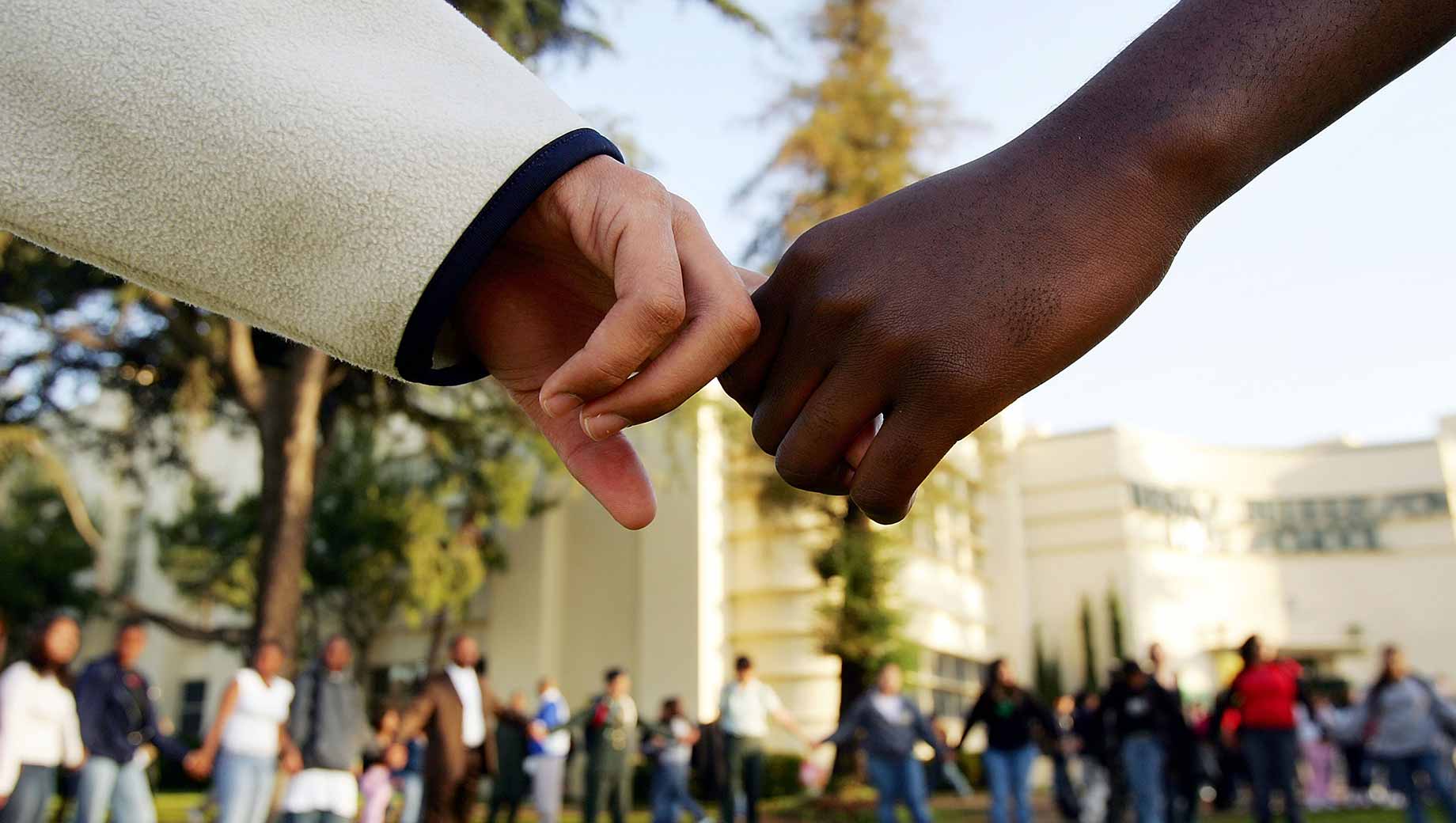
STORY HIGHLIGHTS
Two-year, nine-point drop in overall positive ratings of race relations
33% of Black adults, 43% of White adults say race relations are good
40% of Black adults say relations will eventually work out, down 14 points
WASHINGTON, D.C. -- For the second consecutive year, U.S. adults' positive ratings of relations between Black and White Americans are at their lowest point in more than two decades of measurement. Currently, 42% of Americans say relations between the two groups are "very" or "somewhat" good, while 57% say they are "somewhat" or "very" bad.
The most recent rating of Black-White relations in the U.S. is not statistically different from last year's 44%. However, the reading has eroded nine percentage points over the past two years as the nation has grappled with the murder of George Floyd and the subsequent nationwide protests and calls for racial justice.
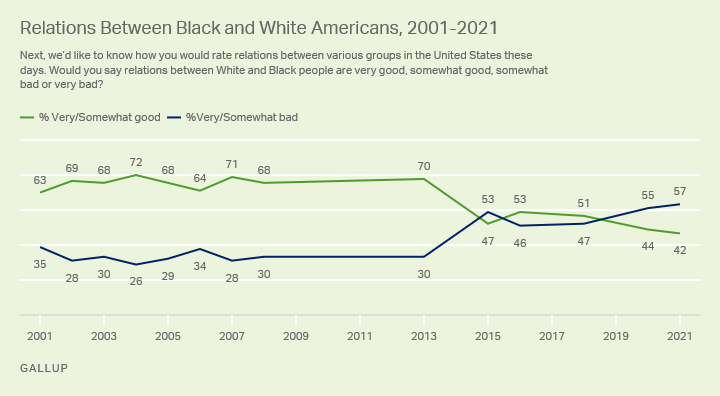
Line graph. Americans' views of race relations between White and Black Americans since 2001. Currently, 42% of U.S. adults think they are very or somewhat good and 57% say they are very or somewhat bad. This is the worst rating recorded by Gallup.
As recently as 2001, 70% of U.S. adults rated Black-White relations positively. That changed after several high-profile killings of unarmed Black people by police officers around the U.S. These incidents precipitated the formation of multiple social justice movements that remain active today.
The latest findings are from a June 1-July 5 Gallup poll that includes an oversample of Black Americans weighted to their correct proportion of the population. During the poll's field period, Derek Chauvin, the former police officer convicted of killing Floyd, was sentenced to one of the longest prison terms ever handed down to a U.S. police officer for unlawful use of deadly force.
Steady 10-Point Gap in Black and White Americans' Views
While White Americans have typically been more likely than Black Americans to say race relations are good, at least slim majorities of both racial groups rated them positively until 2016. Although the racially divisive events of the past few years have taken a toll on both Black and White Americans' views of race relations, Black adults' views continue to lag White adults'. Currently, 10 points separate Black and White adults' views of race relations -- 33% vs. 43%. Each reading is the lowest on record for both racial groups. This gap is identical to last year's but smaller than in 2018 (14 points).
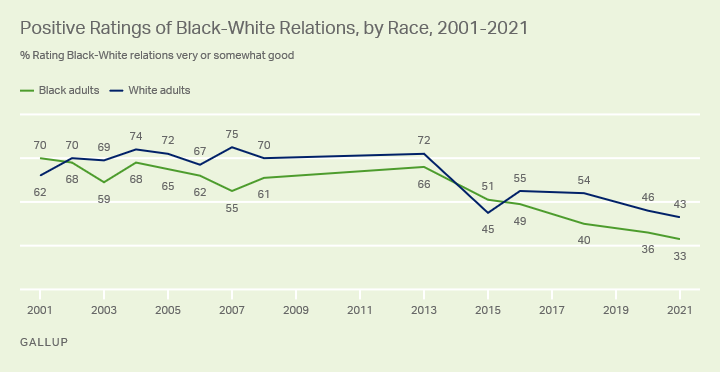
Line graph. Black and White Americans' positive ratings of relations between Black and White people in the U.S. since 2001. Currently, 43% of White U.S. adults and 33% of Black U.S. adults view Black-White relations as very or somewhat good. Each is the lowest recorded since 2001.
Americans' poor assessment of Black-White relations stands alone in their assessments of relations between other U.S. racial and ethnic groups. Majorities of Americans rate relations between Hispanic and White people, Black and Hispanic people, Asian and White people, and Black and Asian people as good. Full details of these data will be reported in a subsequent story.
Overall U.S. Optimism About Future Black-White Relations Steady
Even as Americans rate Black-White relations negatively today, they continue to be optimistic about the future overall. Fifty-seven percent of U.S. adults currently say a solution to the problem of Black-White relations will eventually be worked out and race relations will not always be a problem, while 40% disagree and say it will always be a problem. The optimistic attitude has been at roughly the same level since 2013, including last year's 59% reading.
Aside from a brief uptick to 67% shortly after Barack Obama was elected president in 2008, the public was less optimistic between 1993 and 2011 than they are now.
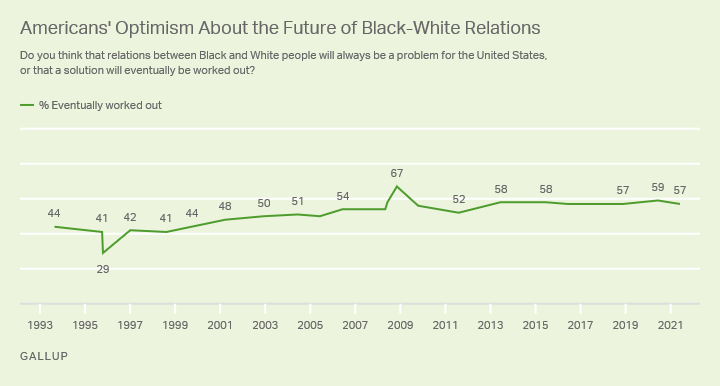
Line graph. Americans' belief that relations between Black and White people will not always be a problem for the U.S. and will eventually be worked out since 1993. Currently, 57% of Americans think they will eventually be worked out.
Black Americans' Greater Optimism Vanishes
The generally positive prediction for racial harmony among the public masks a sharp divide in the views of Black and White Americans. Currently, there is a 20-point gap between Black adults (40%) and White adults (60%) that a solution to racial discord in U.S. society is possible. This is the largest gap recorded in Gallup's three-decade trend, and it is particularly striking given that it comes on the heels of a 10-point uptick in Black Americans' optimism last year.
For the decade prior to Floyd's killing, between 42% and 48% of Black Americans were hopeful about the future of race relations, including 44% in 2019. That jumped to 54% in June 2020, the highest on record. Today, it has fallen 14 points.
The surge of optimism among Black Americans expressed last year may have been owed to the nationwide dialogue about racial inequality that came about in the wake of Floyd's murder and the disproportionate impact of the global pandemic. Yet, as time has passed, Black Americans' hope that there might be an answer to Black-White racial tensions has faded.
By contrast, White Americans' optimism has been steady, with about six in 10 most years, including 60% in 2020 and today, saying a solution will be worked out.
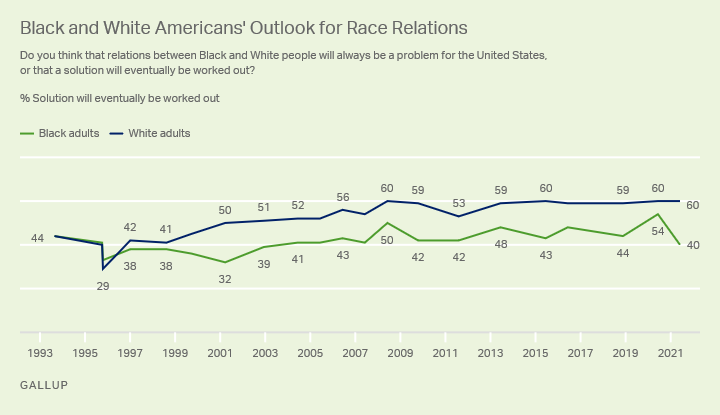
Line graph. Black and White Americans' belief that relations between Black and White people will eventually be worked out since 1993. Currently, 60% of White and 40% of Black Americans think they will be worked out. This marks a 14-point decrease in the views of Black Americans since last year when optimism had improved by 10 points.
Bottom Line
As the nation continues to grapple with racial equity, Americans rate the state of Black-White relations more negatively now than at any time in over two decades. Overall, however, they believe there is still hope for an eventual solution.
However, just one-third of Black Americans now view race relations positively, and the optimism and hope for a solution to racial discord that existed last year have since dissipated.
To stay up to date with the latest Gallup News insights and updates, follow us on Twitter.
Learn more about how the Gallup Poll Social Series works.
View complete question responses and trends (PDF download).
SURVEY METHODS
Above the fold in today's Tribune
ReplyDeleteUS LIFE EXPECTANCY PLUNGED IN 2020
REPORT: Blacks, Hispanics were hit more severely than were white people
note: Capitol letter for the first two and small cap for white
Trib. bought this from the NYT
Needless to say this is Institutional (deliberate) RACISM big time by the news org. with the largest distribution in the world.
FRIENDS, we gotta problem!
It is a proven fact that black men live longer in captivity (i.e.Jail) after all less drugs, homicides, aids, better health care and food. Blame progressives like Kim Foxx for the letting them all loose and thereby decreasing their life expectancy.
DeleteThe "vaccine" will make it even shorter........
DeleteThe CCP wants a race war here. They want us to fight amongst ourselves and use up our ammo and other resources.....then they will launch the real military attack.
ReplyDeleteThere will always be resentment until racist affirmative action is abolished! How do you cure past discrimination with more discrimination?
ReplyDeleteThis was Obamas goal
ReplyDeleteCivil Rights Act in Theory was to make everything equal, but look at all the government requirements asking for sex, age, race, etc. on loans, census, etc. creating and highlighting race by Federal & State Government and created a more unequal situation to all residents. So Johnson created a more racist stage that only was fired up by Obama.
ReplyDeleteHave you noticed how white people are not on commercials on TV. And that couples on commercials are either black with no Ebonics accent or black and white couples.
ReplyDeleteWhy no orientals on Commercials, almost no Hispanics on commercials and most likely no one legged midgets on commercials.